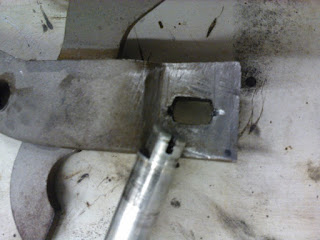The epoxy on the interior was once more ground and
Dinitrol 410 UV seam sealer was (tooth)brushed on the sheet metal seams before a layer of
Temadur 50 in 'signal red' tone was sprayed to finish the red coating on inside roof and elsewhere. It seems to be very hard to find a modern formula for the tones of color. The paint resellers cannot match the Ditzler codes from the '60s to any of the formulas found in their databases. In '65 the the interior is
bright red , but in '66 it turned to more dark maroon. I took a wild guess when accepting the 'signal red' without being able to compare it with the interior carpet or dash pad as I do not have them yet.



The steering column was disassembled and the tube was sanded and painted with the same color. During the disassembly I succeeded to break the wiring support that is placed inside the tube for keeping the wires not messing with the steering shaft. This support plate is not available as replacement so I had to design an additional reinforcing support for it.
 |
| The column collar is slid in place between the wire accesses |
 |
| The connectors we pulled out through the opening |
 |
| Holes were driller for the additional support |
 |
| The support plate screwed in place |
 |
| Wiring is in place |
 |
| The hardware for securing the collar and turn signal assembly |
 |
| Assembly positioned... |
 |
| ...and secured with square head screws |
 |
| Ready for placing the collar |
Maybe I regret it later but - as I only have limited amount of storage space especially for the reconditioned parts - I move on to installing the steering column and the under-the-dash components. The reasons for regrets might be that the tone of color is absolutely wrong and I'll have to re-paint the dash and column and the case of possible bad protection for over-spray during the painting of the body. To proceed with the steering column install calls for first installing the gasket and firewall pad which I re-manufactured from 30 mm sound insulator using the old one as a template. The insulator has adhesive surface on the other side so the button fasteners are not required but those will be added in places where the original holes still exist.
 |
| Steering column firewall gasket |
 |
| Adhesive firewall insulator |
Once the pad had been cut to fit and placed in the pedal assembly was positioned and bolted in as the steering column will be secured to dash with common stud bolts. The lower end of the column tube was painted black so the red will not be visible in the engine department.
 |
| Pedal assembly |
 |
| End tip painted black |
 |
| Tube end rubber went in first |
The fresh air vent was cleaned and painted. In the below picture the operating knob bracket is upside down which I realized too late after the first pursuit to install. Easier to check first that rotate it under the dash.
 |
| Driver side fresh air vent |
 |
| Steering column in place |
 |
| Fresh air vent installed |






























































